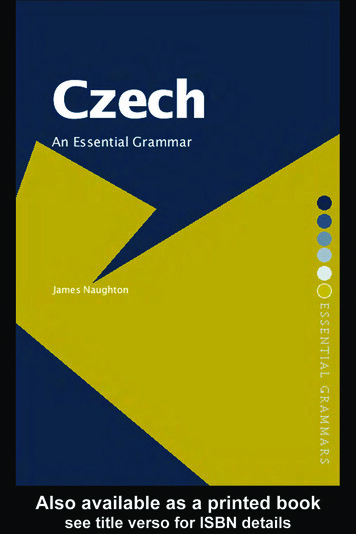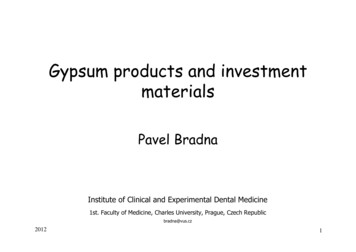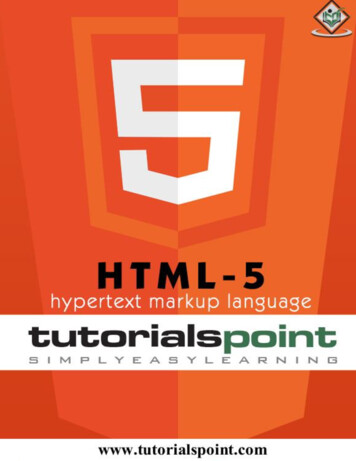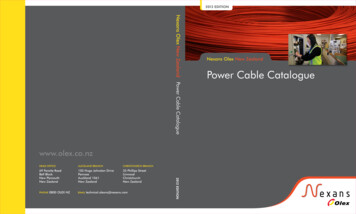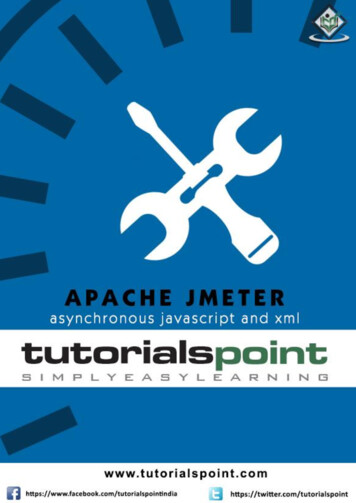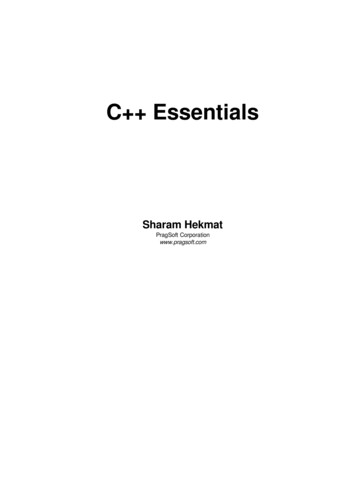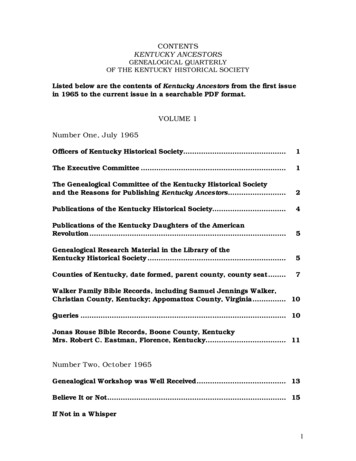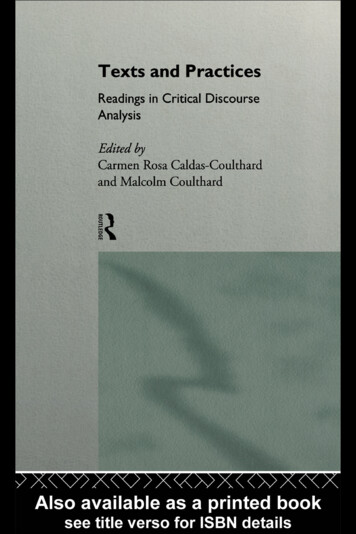
Transcription
ContentsNotes on contributorsPrefaceviixiPart I Critical discourse theory1On critical linguisticsRoger Fowler32Representational resources and the production of subjectivity:Questions for the theoretical development of Critical DiscourseAnalysis in a multicultural societyGunther Kress153The representation of social actorsTheo van Leeuwen324Technologisation of discourseNorman Fairclough715Discourse, power and accessTeun A.van Dijk84Part II Texts and practices: Critical approaches6The genesis of racist discourse in Austria since 1989Ruth Wodak1077Ethnic, racial and tribal: The language of racism?Ramesh Krishnamurthy1298A clause-relational analysis of selected dictionary entries:Contrast and compatibility in the definitions of ‘man’ and‘woman’Michael Hoeyv150
vi910ContentsThe official version: Audience manipulation in policerecords of interviews with suspectsMalcolm Coulthard166Conflict talk in a psychiatric discharge interview: Strugglingbetween personal and official footingsBranca Telles Ribeiro17911Problems with the representation of face and its manifestationsin the discourse of the ‘old-old’194Dino Preti12‘Guilt over games boys play’: Coherence as a focus forexamining the constitution of heterosexual subjectivityon a problem pageVal Gough and Mary Talbot1314Barking up the wrong tree? Male hegemony, discriminationagainst women and the reporting of bestiality in theZimbabwean pressAndrew Morrison214231‘Women who pay for sex. And enjoy it’: Transgression versusmorality in women’s magazinesCarmen Rosa Caldas-Coulthard250BibliographyIndex271285
Chapter 3The representation of social actorsTheo van Leeuwen1 INTRODUCTIONThe question I shall attempt to answer in this chapter can be formulatedsimply: what are the ways in which social actors can be represented inEnglish discourse? Which choices does the English language give us forreferring to people? In addition I shall address another, more specificquestion: how are the relevant social actors represented in an instance of aparticular kind of racist discourse—a discourse which representsimmigration in a way that is founded on fear—the fear of loss of livelihoodand the fear of loss of cultural identity as a result of the ‘influx’ ofimmigrants who are perceived as ‘other’, ‘different’ and ‘threatening’.The first of these two questions is a grammatical one, if, with Halliday,we take a grammar to be a ‘meaning potential’ (‘what can be said’) ratherthan a set of rules (‘what must be said’). Yet, unlike many otherlinguistically oriented forms of Critical Discourse Analysis, I shall notstart out from linguistic operations such as nominalisation and passiveagent deletion, or from linguistic categories such as the categories oftransitivity, but instead seek to draw up a sociosemantic inventory of theways in which social actors can be represented, and to establish thesociological and critical relevance of my categories before I turn to thequestion of how they are realised linguistically.There are two reasons for doing so. The first stems from the lack of biuniqueness of language. Agency, for instance, as a sociological concept, isof major and classic importance in Critical Discourse Analysis: in whichcontexts are which social actors represented as ‘agents’ and which as‘patients’? But sociological agency is not always realised by linguisticagency, by the grammatical role of ‘Agent’; it can also be realised in manyother ways, for instance by possessive pronouns (as in ‘our intake ofmigrants’) or by a prepositional phrase with ‘from’, as in example 1.1, inwhich the grammatical Agent is sociologically ‘patient’:32
The representation of social actors331.1 People of Asian descent say they received a sudden cold-shoulder fromneighbours and co-workers.There is no neat fit between sociological and linguistic categories, and ifCritical Discourse Analysis, in investigating for instance therepresentation of agency, ties itself in too closely to specific linguisticoperations or categories, many relevant instances of agency might beoverlooked. One cannot, it seems, have it both ways with language.Either theory and method are formally neat but semantically messy (as inthe dictionary: one form, many meanings), or they are semantically neatbut formally messy (as in the thesaurus: one concept, many possiblerealisations). Linguists tend towards preserving the unity of formalcategories. I shall here attempt the opposite approach, hoping to providea set of relevant categories for investigating the representation of socialactors in discourse.Halliday (1985: ch. 10) has approached the problem of the lack ofbiuniqueness in another way, through his theory of grammatical metaphor:certain linguistic realisations are ‘literal’ or ‘congruent’, others‘metaphorical’ or ‘incongruent’. But in Halliday’s account ‘congruent’would seem to mean ‘congruent with the grammatical system’, rather than‘congruent with reality’, the kind of congruence which, in the end,underlies most definitions of metaphor. For Halliday a clause like ‘Thereport confirms ’ would not be a metaphor, because it does not violatethe criterion that verbal processes do not require a human ‘Sayer’ as theirsubject (cf. Halliday, 1985:129). I would prefer to see ‘the reportconfirms ’ as just one of the ways in which we can refer to social actorsin their role as ‘Savers’, as metaphorical or unmetaphorical as any otherway, but endowed with its own specific sociosemantic import and hencesocial distribution: it is likely to be found in contexts where the authorityof utterances is bound up with the official status or role of ‘Savers’ and/orthe official status of genres. In the context of literature, on the other hand,it would be less likely to occur, because there the authority of utterances isbound up with the charismatic personality of the writer, so that we wouldexpect ‘Shakespeare says ’ rather than ‘the play says ’, for instance. Iwould therefore prefer to ask: how can ‘Sayers’ be represented—impersonally or personally, individually or collectively, by reference totheir person or their utterance, etc.—without privileging any of thesechoices as more ‘literal’ than others, and without thereby also privilegingthe context or contexts in which one or the other tends to occur as morenormative than others.The second reason is somewhat different, and follows from theassumption that meaning belongs to culture rather than to language andcannot be tied to any specific semiotic. Language can represent socialactions impersonally, as in this headline:
34Texts and practices1.2 Allied air activity over battlefield intensifiesbut so can pictures—think of the difference between, on the one hand,‘personalised’ pictures of bombardments, say in feature film sequencesshowing, in close up, the faces of the crew as they drop the bombs, as wellas the faces of the villagers down below as they are about to be bombed,and, on the other hand, diagrams of the same event, for instance maps withlarge arrows pointing at the targets and schematic drawings representingthe explosions.There is no space here to explore this point in detail (cf. van Leeuwen,1987, for the representation of social actors in music; Kress and vanLeeuwen, 1990, and van Leeuwen, 1993a, for parallels between languageand images). Nevertheless, the categories I shall propose in this chaptershould, in principle, be seen as pan-semiotic: a given culture (or a givencontext within a culture) has not only its own, specific array of ways ofrepresenting the social world, but also its own specific ways of mappingthe different semiotics on to this array, of prescribing, with greater orlesser strictness, what can be realised verbally as well as visually, whatonly verbally, what only visually, and so on. And these arrangements willalso be subject to historical change, sometimes even violent change, as iniconoclasms. The point is important for Critical Discourse Analysis, for,with the increasing use of visual representation in a wide range ofcontexts, it becomes more and more pressing to be able to ask the samecritical questions with regard to both verbal and visual representations,indeed, with regard to representations in all the ‘media’ that form part ofcontemporary ‘multimedia’ texts.Despite all this, this chapter still attempts to be grounded in linguistics.Each of the representational choices I shall propose will be tied to specificlinguistic or rhetorical realisations. To return to my earlier examples, in thecase of ‘Shakespeare’ the representational choice is that of ‘nomination’and the realisation the use of a proper name, while in the case of ‘the reportconfirms ’ the representational choice is that of ‘utteranceautonomisation’ (see section 11 below) and the realisation the substitutionof the utterance for its Sayer, hence a form of metonymical reference. Thedifference is that my primary focus is on sociological categories(‘nomination’, ‘agency’, etc.) rather than on linguistic categories(‘nominalisation’, ‘passive agent deletion’, etc.) and that the systemnetwork, the ‘array of choices’, I shall present in section 13 will range overa variety of linguistic and rhetorical phenomena, and find its unity in theconcept of ‘social actor’, rather than in a linguistic concept such as, forinstance, ‘the nominal group’.Finally, the chapter is part of a larger project (see van Leeuwen,1993a; 1993b) in which I am attempting in addition to map how otherelements of social practices (the social activities that constitute them, the
The representation of social actors35times when and the locations where they occur, the dress and bodygrooming that go with them, etc.) are represented, and howrepresentations add further elements to this, for instance the purposesand legitimations of the social practices, and the sentiments thataccompany them. In short, the question addressed in this chapter is partof a larger question: how are social practices transformed into discoursesabout social practices—and this both in the sense of what means we havefor doing so, and in the sense of how we actually do it in specificinstitutional contexts which have specific relations with the socialpractices of which they produce representations.2 ‘OUR RACE ODYSSEY’Below I reproduce the first three sections of ‘Our Race Odyssey’, the textfrom which I shall draw most of my examples, and which I use todemonstrate how the categories I propose may be used in text analysis. Itwas published as the leading feature article in ‘Spectrum’, the Saturdaysupplement of the Sydney Morning Herald, a conservative broadsheetnewspaper, on 12 May 1990.The descriptive framework I shall present in the following sections wasworked out with the aid of a much larger and generically diverse corpus oftexts which included fictional narratives, comic strips, news stories,newspaper editorials, advertisements, textbooks and scholarly essays, alldealing, in some form or other, with the subject of schooling, and morespecifically with the transition from home to school (van Leeuwen,1993b). As one text can never provide instances of all the categories andmodes of representation, I shall, throughout the chapter, also use examplesfrom this corpus.1 2001: Our Race Odyssey.2 This country will be vastly different next century if Australians feelthey cannot voice legitimate fears about immigration without beingbranded racists, argues David Jenkins.3 In Florence last month 80 young white thugs, many wearing costumemasks and armed with iron bars, roamed the narrow cobbled streetsattacking African street vendors.4 In France, where non-European immigrants make up 6.5 per cent ofthe population, former president Valéry Giscard d’Estaing proposed atotal halt to immigration.5 In Japan, a nation with a strong tradition of keeping foreigners atarm’s length, similar concerns are being expressed about a meretrickle of Third World immigrants.6 Japan’s National Police Agency had to apologise recently forcirculating an internal memo to police stations claiming that Pakistanis
3678910111213141516171819202122232425Texts and practicesworking in Japan ‘have a unique body odour’, carry infectious skindiseases and tell lies ‘under the name of Allah’.The mayor of Kawaguchi has ‘joked’ that with so many dark-skinnedforeigners in town, Japanese are having trouble seeing them at night.In Peru, where the son of Japanese immigrants is a presidential frontrunner, the situation is reversed.A racist backlash against ethnic Asians has been unleashed by thosewho resent the prominence of centrist candidate Alberto Fujimori.People of Asian descent say they have been insulted in the street,denied entry to elegant restaurants and received a sudden coldshoulder from neighbours and co-workers.In Canada, where the 250,000-strong Sikh community has pressed forthe right to have Mounties in turbans and where 22,000 Hong KongChinese arrived last year, bringing bulging wallets to cities likeVancouver, racial tolerance is wearing thin.‘Native Vancouverites will be made to feel like strangers in their owncity as the influx of Asians and their capital freezes them out’, wroteone reader of The Province newspaper in Vancouver.If you were sitting in Canberra and doing no more than reading thedaily newspapers you would be entitled to be a bit concerned by thesedevelopments.They italicise the lesson that people, whatever their race, display theirless attractive characteristics when they feel threatened and unable tocope with rapid change in the society around them.They highlight the fact that racism is seldom far below the surface—whether it is in Western Europe, in Asia, in North or South America.They may even call into question some aspects of Australia’simmigration programme, which is now running at close to recordlevels, with annual net migration of about 150,000, including 60,000migrants from Asia.Is the Australian Government concerned?Not a bit.Prime Minister Bob Hawke says he is ‘philosophically’ a highmigration man.He thinks our c
but formally messy (as in the thesaurus: one concept, many possible realisations). Linguists tend towards preserving the unity of formal categories. I shall here attempt the opposite approach, hoping to provide a set of relevant categories for investigating the representation of social actors in discourse.
